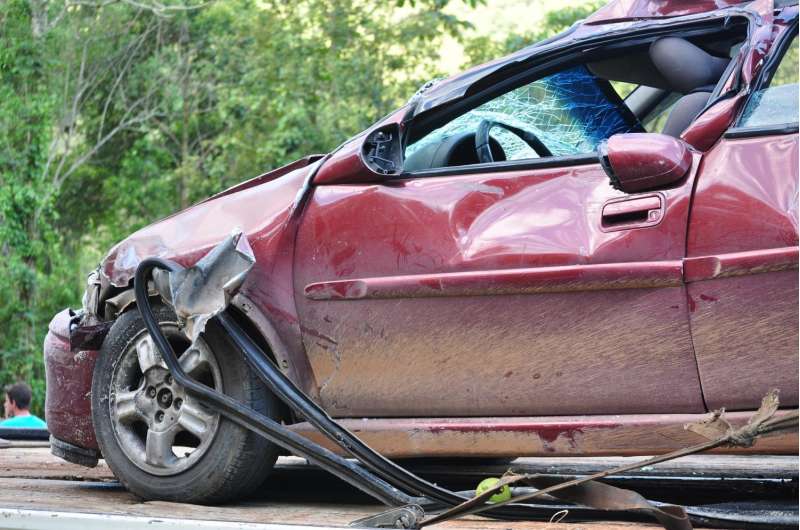Opioids, NSAIDs no different overall for persistent pain after vehicle crashes

Persistent pain is common among the nearly 4 million Americans who arrive each year at hospital emergency departments (EDs) after car crashes. A new study in the journal Pain that compared the two most common pain-relief drugs—NSAIDs such as ibuprofen and opioids such as oxycodone—found that the risk of reporting persistent pain six weeks after a crash was not statistically different among patients prescribed either medication at the ED.
What did differ significantly was the likelihood that people initially prescribed opioids, which can be addictive, would still be using them by that time.
"You'd think there would be a wealth of studies comparing our 'go-to' pain meds, but there just aren't," said Dr. Francesca Beaudoin, lead author of the study, assistant professor of emergency medicine in Brown University's Warren Alpert School of Medicine and an ED physician at Rhode Island Hospital.
"But now that opioids are under fire, it's forcing us to ask: What is the best treatment, who is it best for and under what conditions? As an emergency physician, I prescribe these drugs all the time. Does what I am giving to people have any impact on the pain outcomes that matter to them?"
Comparing cases
To produce an informative comparison, Beaudoin teamed with researchers including Roee Gutman, assistant professor of biostatistics in the Brown University School of Public Health, to analyze the prescribing and pain outcomes at six weeks of 948 people who experienced car crashes. Their data was drawn from a larger study conducted in eight hospitals in Florida, Massachusetts, Michigan and New York between February 2009 and October 2011.
In the analysis, the researchers were careful to make fair comparisons between the two analgesics by comparing cases that were as similar as possible, except in which of the two pain medications was prescribed. In all, they considered more than 50 variables—from socio-demographic characteristics of the patients to baseline reported pain to which body regions hurt, the characteristics of the crash and patient medical history—in matching cases for comparison. This kind of statistical accounting was important because, for example, patients who were prescribed opioids were ones who reported greater pain levels in the ED. Without controlling for that, any comparison between opioids and NSAIDs would have been unfair to opioids because they were prescribed to patients who at baseline had more pain.
"We tried to find 'twins' where one got the opioid and the other got the NSAID," Gutman said.
In the final analysis, they were able to compare 284 of the cases head-to-head.
What the researchers found is that six weeks after their crash, similar patients were 7.2 percent more likely to report moderate to severe pain if they were prescribed opioids than NSAIDS; however, this difference was too small to be statistically significant.
In all of the cases, patients were prescribed a supply of pain medications to last just a few days, but the researchers measured a significantly larger risk, 17.5 percent, that people prescribed opioids were still using opioids after six weeks than people prescribed NSAIDs would be using NSAIDs.
Individualized treatment
Though there were no significant differences in pain risk overall, Beaudoin and Gutman said they saw signs that different patients responded differently to pain management. Some likely would benefit most from opioids, some from NSAIDs, some to neither, and some could have used either.
Based on the data, they wrote, they could predict: "Approximately one in five individuals would not have persistent moderate or severe pain six weeks after [a crash] if they were prescribed an opioid, but they would have had moderate to severe pain had they been prescribed an NSAID. Conversely, one in four patients would have only experienced such treatment success with an NSAID."
The next step in the research, Beaudoin said, is to try to identify what characteristics best predict which therapy is best for which patients. Such a system could help doctors manage patients' pain while only prescribing opioids for people who really need them.
"Wouldn't it be nice if I had a tool I could use to ask maybe five questions and know which treatment you would be most likely to benefit from?" Beaudoin asked.
More information: Francesca L. Beaudoin et al, Persistent pain after motor vehicle collision, PAIN (2016). DOI: 10.1097/j.pain.0000000000000756
















